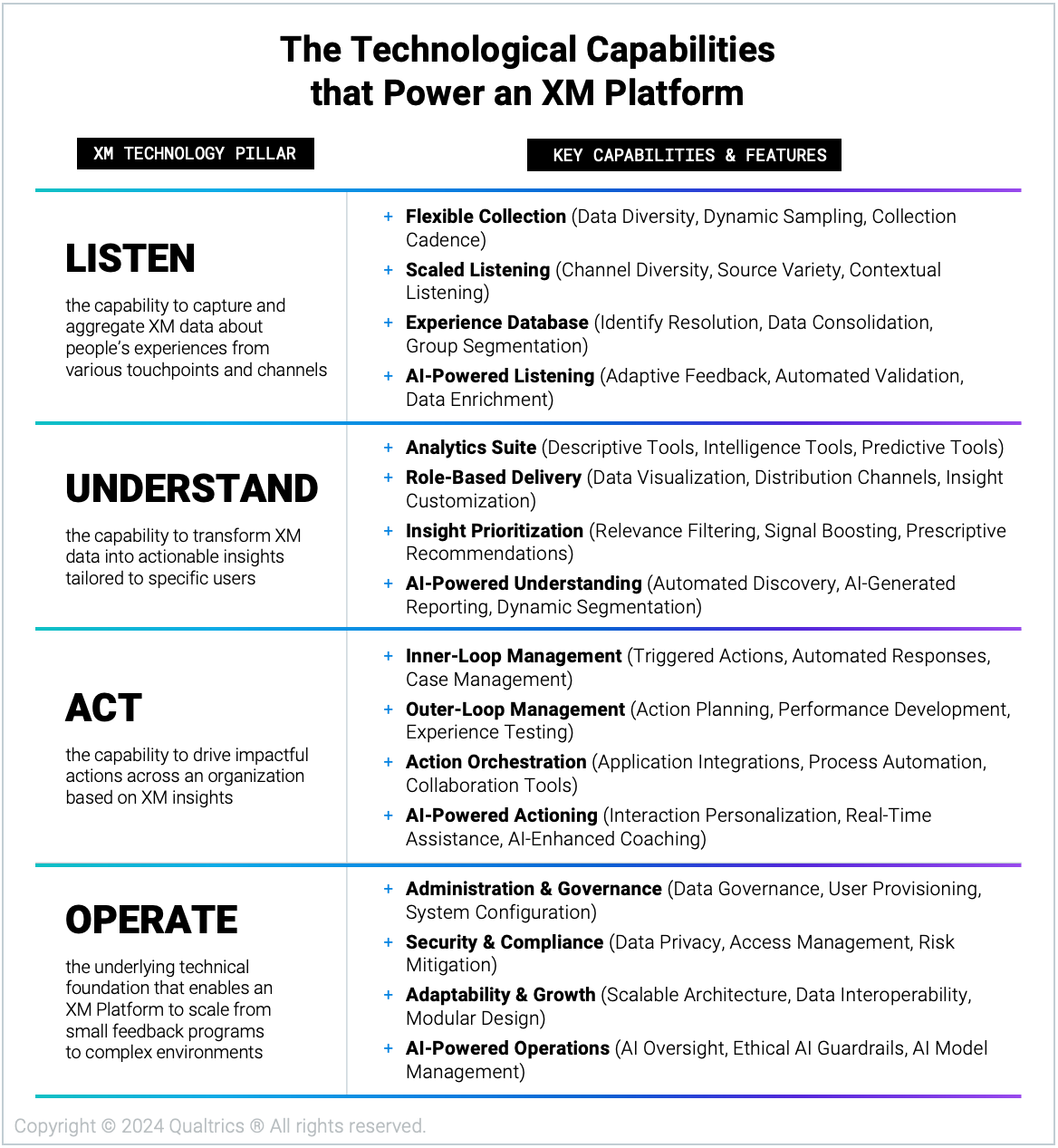This is the second article in XM Institute’s series on XM Technology.
In the first article, Introducing the Four Technology Pillars of an Effective XM Platform, we explored how Experience Management (XM) can help organizations navigate today’s increasingly uncertain and complex business landscape, and we examined the Technology component of the XM Operating Framework, which is made up of four pillars: Listen, Understand, Act, and Operate. In this article, we are looking at the different technological capabilities and features that make up an effective XM Platform. In the final article, The Five Levels of Technology Maturity for XM Programs, we break down how these capabilities evolve over time as they progress through five levels of Technology Maturity.
The Four Pillars of an Effective XM Platform
XM Technology refers to the platform that allows XM practices to scale consistently across an organization. This XM Platform serves as a central nervous system for XM, capturing, analyzing, and distributing insights that drive both automated processes and better decision-making at all levels of the organization. By embedding a holistic, dynamic understanding of people’s experiences into the operating rhythm of the business, the platform enables the organization to adapt and thrive in today’s unpredictable business environment.
To help organizations understand the characteristics of an effective XM Platform, XM Institute has identified four technology pillars:
- Listen: The capability to capture and aggregate XM data about people’s experiences from various touchpoints and channels.
- Understand: The capability to transform XM data into actionable insights tailored to specific users.
- Act: The capability to drive impactful actions across an organization based on XM insights.
- Operate: The underlying technical foundation that enables an XM Platform to scale from small feedback programs to complex environments.

Pillar #1: Listen
Listen refers to the capability to capture and aggregate XM data about people’s experiences from various touchpoints and channels.
XM data can be composed of experience data about people’s expectations, perceptions, and attitudes (e.g., survey responses, social media/online reviews, in-product feedback, in-depth interviews, call/voice data, focus groups, etc.) as well as relevant behavioral data (e.g., digital behavior, interaction history, product usage) and operational data (e.g., demographic information, sales data, employee records).
While organizations can collect experience, behavioral, and operational XM data in ad-hoc ways through a variety of different technologies, an XM Platform offers a systematic approach to listening. It centralizes XM data collection and management, providing structure and consistency regardless of where the listening activities occur. The platform should also support a range of listening mechanisms (beyond traditional surveys) to capture the full range of people’s perceptions and reactions in real time across touchpoints. By consolidating relevant XM data from various sources – and ensuring its quality, standardization, and consistency – an XM Platform helps the organization determine who to listen to, when to listen, and what to listen for. This provides the foundation for impactful analysis and action across the following technology pillars.
Here are four platform capabilities for the Listen pillar:
- Flexible Collection. An XM Platform should be able to systematically gather a wide array of XM data types through various collection methods. And these collection methods should not be static. Rather the platform should enable the organization to dynamically adjust its listening posts and sampling strategies to ensure it’s capturing the right data from the right people at the right time in order to support the business’s key decisions and activities. Compared to rigid, survey-based approaches, this type of flexible XM data collection will yield more relevant and actionable insights that reflect, not just what people say, but their behaviors, emotional responses, and individual contexts. Key features here include:
- Data Diversity: The ability to capture XM data in both structured formats (like multiple-choice responses on surveys) and unstructured formats (like open-ended comments, support conversations, focus groups, in-depth interviews, or online reviews).
- Dynamic Sampling: The ability to tailor feedback collection methods to specific segments and individuals based on things like their preferences, segment, journey, history, and real-time behaviors – as well as current insights needs of the XM program or organization.
- Collection Cadence: The ability to adjust the frequency and cadence of data collection (e.g., continuous, periodic, ad hoc, event-triggered, post-journey) to capture signals and feedback at the moments that are timely for both respondents and insights users.
- Scaled Listening. An XM Platform should be able to capture and consolidate XM data from a diverse range of interaction channels and devices, both solicited and unsolicited. Omnichannel listening is essential for developing a unified and comprehensive understanding of people’s experiences, allowing the organization to identify consistent themes and pain points across journeys and prioritize the actions that will have the greatest impact on experience and business outcomes. Key features here include:
- Channel Diversity: The ability to capture XM data through both solicited channels (such as post-transaction satisfaction surveys, notes from employee exit interviews, third-party sample/panel data, or zero-party data) as well as unsolicited channels (such as social media platforms, online reviews, contact center transcripts, emails, work process logs, or digital behavioral analytics). Unsolicited channels could also include external sources like industry benchmarks, third-party databases, the internet of things, digital sensors, and competitive intelligence.
- Source Variety: The ability to collect feedback through a variety of different listening mechanisms to ensure organizations can reach respondents through their preferred channels in a way that is convenient and engaging for them. Common examples of these listening sources include emails, SMS, QR codes, apps, websites, voice recordings, transcripts, IVR, video recordings, SMS, and social media/online review platforms
- Contextual Listening: The ability to tailor feedback collection methods to specific channels, devices, and contact preferences– optimizing the timing, length, format, and design for maximum engagement. This might involve adapting survey design for mobile devices, triggering an active intercept in response to real-time digital behaviors and frustration signals, or capturing GPS/Beacon data in physical locations.
- Experience Database. An XM Platform should be able to centralize and store XM data from different sources (e.g., surveys, call transcripts, social, CRMs, HCMs) to create a unified record for each individual person. Organizing this data around individuals – rather than channels, events, departments, products, etc. – provides a holistic view of each person’s end-to-end journey with the organization. This unified, human-centric view serves as the foundation for tailored experiences, communications, and recommendations at both individual and segment levels. Key features here include:
- Identity Resolution: The ability to accurately match and link multiple records or identifiers – like email addresses, phone numbers, social media handles – to an individual, ensuring that all data points are consolidated into a single, unified profile. This prevents duplicate records and ensures a complete view of each person’s interactions and experiences.
- Data Consolidation: The ability to seamlessly aggregate XM data from different sources and business systems (e.g., digital behavioral analytics, surveys, CRMs, HCMs, and other relevant repositories) to create a holistic view of each individual.
- Group Segmentation: The ability to group people into meaningful segments based on their enriched profiles, accounting for characteristics like needs, behaviors, preferences, demographics, and interaction history. To make these segments as rich as possible, these segments should be informed by data from a wide range of sources, everything from qualitative research to interaction history to industry or federal datasets.
- AI-Powered Listening. An XM Platform should be able to leverage artificial intelligence (AI) and machine learning (ML) to augment, tailor, or automate various aspects of its listening activities. This enables the platform to actively and continuously adapt and improve its XM data collection strategies, ensuring maximum relevance and effectiveness in capturing the information necessary to understand people’s experiences. Key features here include:
- Adaptive Feedback: The ability to use AI and ML to refine listening strategies in real-time, tailoring the approach to match the specific needs and context of each individual interaction. This includes automatically adjusting survey questions, feedback triggers, and listening mechanisms based on someone’s individual behaviors, preferences, and context.
- Automated Validation: The ability to use AI and ML to automatically identify and correct errors, inconsistencies, or missing values in collected data, ensuring its accuracy and reliability for analysis.
- Data Enrichment: The ability to use AI and ML to enhance and augment the value and utility of collected data. This includes generating synthetic or augmented XM data.
Pillar #2: Understand
Understand is the capability to transform XM data into actionable insights tailored to specific users.
While data collection is foundational, the true value of an XM platform lies in its ability to extract meaningful insights that drive informed decision-making. So as the volume and variety of XM data increases, the platform must leverage a suite of analytics and visualization tools to uncover hidden patterns, predict trends, and deliver insights that are both powerful and intuitive.
An effective XM platform is more than a tool for data analysts. It democratizes access to sophisticated analysis, empowering individuals across the organization – from frontline staff to executives – with the information they need to make faster, smarter decisions. This pillar is about providing every insights user with intelligence that is contextualized for their particular needs and presented in a way that is easy for them to understand and act on. By continually uncovering and sharing powerful XM insights, the platform transforms XM data into a strategic asset that helps the organization anticipate and respond to its environment.
Here are four platform capabilities for the Understand pillar:
- Analytics Suite. An XM Platform should be able to apply a comprehensive set of analytical tools and statistical techniques to explore, analyze, and interpret XM data, uncovering hidden patterns, trends, and relationships that support informed decision-making. This allows the organization to move beyond basic metrics reporting and surface-level observations to build a deeper understanding of the factors that influence people’s experiences. Key features here include:
- Descriptive Tools: Features that summarize and visualize key metrics and trends in XM data. This includes calculating averages, distributions, variability, and other descriptive statistics, as well as generating charts, graphs, and tables to present the data in an easily understandable format.
- Intelligence Tools: Features that uncover deeper patterns and relationships within XM data, identifying which factors influence outcomes. This includes employing methods like correlation analysis, regression analysis, significance testing, root cause analysis, and ANOVA to pinpoint drivers of performance and areas for improvement.
- Predictive Tools: Features that forecast future trends, behaviors, and outcomes based on historical data and statistical models, allowing insights users to anticipate needs, proactively address issues, and make informed decisions that optimize experiences. This includes using methods like predictive modeling, time series forecasting, and – in more advanced XM Platforms – machine learning algorithms.
- Role-Based Delivery. An XM Platform should be able to tailor the presentation and delivery of actionable intelligence to specific users and roles, ensuring that the information is relevant, accessible, and actionable for everyone across the organization. This supports data-driven decision-making across all levels and functions, leading to more agile and effective responses to evolving business and experience needs. Key features here include:
- Data Visualization: The ability to present insights in diverse formats that are easy for insights users to interpret and act on. This includes visualizing both structured, quantitative data as well as unstructured, qualitative data, such as open-text comments and highlight reels.
- Distribution Channels: The ability to deliver insights through a variety of different channels and integrate with existing business applications, ensuring that information reaches the right stakeholders in the right places. This requires the XM Platform to support multiple insights delivery mechanisms (e.g., email, in-app notifications, BI integrations) and integrate with popular enterprise systems (e.g., CRMs, HCMs, Slack, Jira, Teams).
- Insight Customization: The ability to tailor the content, format, and frequency of insights to align with the specific roles, needs, and preferences of users. This includes options for role-based dashboards, customizable reports, personalized alert settings, and the ability to filter and sort insights based on individual preferences. This type of customization empowers each user to focus only on the information that’s most relevant to them, driving faster decisions and actions.
- Insight Prioritization. An XM Platform should be able to prioritize the insights generated by the XM Platform, ensuring that the most valuable and relevant information is surfaced for individual users. This allows people and teams across the organization to focus their resources and attention on the areas that matter most, maximizing the ROI of their efforts and driving meaningful experience improvements. Key features here include:
- Relevance Filtering: The ability to evaluate the potential impact and relevance of insights based on various factors, like key metrics, user roles, and business or XM program objectives.
- Signal Boosting: The ability to filter out irrelevant or redundant information, consolidate similar insights, and highlight key trends and patterns to improve clarity and focus. This includes techniques for automated insight clustering, anomaly detection, and outlier removal as well as customizable filters and visualization tools designed to help users focus on the most important signals in the data.
- Prescriptive Recommendations: The ability to assess the feasibility of implementing insights and generate actionable recommendations, including suggested prioritization based on potential impact and relevance. For example, based on feedback and churn prediction models, the platform might recommend prioritizing improvements to the onboarding process to increase retention rates.
- AI-Powered Understanding. An XM Platform should be able to leverage AI and ML to automate and enhance both data analysis and reporting. This allows organizations to extract maximum value from their data, uncover hidden opportunities, proactively resolve issues, and drive more effective decisions across the business. Key features here include:
- Automated Discovery: The ability to use AI and ML to automatically extract and model meaningful insights, trends, patterns, correlations, and anomalies from large volumes of structured and unstructured data. This includes natural language processing (NLP), sentiment analysis, topic modeling, deep learning for image/video analysis, and other machine learning algorithms to analyze and interpret data.
- AI-Generated Reporting: The ability to use AI – especially Generative AI – and ML to create and deliver insights in a variety of user-friendly formats, including automated reports, natural language summaries, and AI-generated visualizations. It should also allow users to explore findings interactively, like enabling users to engage with the data using natural language prompts or providing dedicated spaces where they can investigate data in a controlled environment.
- Dynamic Segmentation: The ability to use AI and ML to continuously identify and refine segments based on a wide range of data points, including personal traits, behaviors, or goals. To support the creation of increasingly nuanced and adaptive segments that evolve over time, these capabilities should integrate with the Experience Database under ‘Listen’ and include tools like ML algorithms for clustering and classification, rule-based segmentation engines, and predictive segmentation modeling.
Pillar #3: Act
Act is the capability to drive impactful actions across an organization based on XM insights.
Insights exist to facilitate action. An XM Platform’s value ultimately lies in its ability to scale and enable XM-centric practices across the entire organization – driving improvements, innovations, and initiatives at both an organizational and individual level. So as the volume, velocity, and veracity of XM insights grows, the platform must enable efficient – and often automated – mechanisms for putting this intelligence to use.
These actions can’t happen sporadically or on an ad hoc basis. The XM Platform must help embed the insights it’s generated into the organization’s daily operating rhythm by integrating with other business systems and processes. By continuously driving timely and relevant improvements that not only improve the experiences the organization delivers but also increase its operational efficiency and productivity, the XM Platform becomes an important engine for competitive advantage.
Here are four platform capabilities for the Act pillar:
- Inner-Loop Management. An XM Platform should be able to trigger immediate, automated actions in response to data, analytics, or feedback – following up with people who have been affected by an experience. Closing the loop is an essential capability as it allows the organization to address issues promptly, prevent or manage the need for escalations, and demonstrate its commitment to continuous improvement. Key features here include:
- Triggered Actions: The ability to automatically initiate individual, immediate actions in response to specific feedback or events. This includes sending notifications, updating records, or assigning tasks.
- Automated Responses: The ability to provide immediate, personalized, and predefined responses to feedback or inquiries, acknowledging receipt and demonstrating attentiveness. The XM platform should enable the creation and customization of automated response templates – triggered by specific feedback criteria or events – to let people know their feedback has been received.
- Case Management: The ability to efficiently track, manage, and escalate XM-related issues. A centralized case management system should include features for tracking, prioritizing, escalating, and resolving XM-related issues, as well as generating queries, service requests, and incident reports.
- Outer-Loop Management. An XM Platform should be able to translate XM insights into strategic, data-driven actions that systematically improve experiences across the organization. While outer-loop activities will largely be implemented by people, the XM Platform is critical for supplying those people with the information they need to make smart decisions that align with the organization’s broader strategy and objectives. Key features here include:
- Action Planning: The ability to translate insights into concrete action plans, track progress, and measure the impact of improvement initiatives. For example, after employee engagement survey results reveal a decline in satisfaction with work-life balance, the platform might help the HR team create an action plan to address this, recommending specific tasks like reviewing flexible work policies, organizing wellness workshops, and setting clear communication channels for employees to express their concerns.
- Performance Development: The ability to leverage XM insights to provide personalized guidance, feedback, and recommendations to individuals, teams, or entities to help improve their performance. For instance, the platform might analyze sales representative performance data and provide their manager with specific coaching recommendations and resources to help them improve their customer interactions and close rates.
- Experience Testing: The ability to design and execute controlled experiments to test and compare different XM actions or changes. The XM Platform should support experimentation methodologies like A/B testing, multivariate testing, conjoint analysis, concept testing, idea screening, UX research, and creative/message testing, as well as the deployment of experiment variations across different channels. This allows teams to uncover and test potential experience improvements and innovations, generating objective data they can use to make better investment decisions.
- Action Orchestration. An XM Platform should be able to seamlessly integrate with other business systems and automate workflows, ensuring that insights are embedded into the daily operations of groups across the organization. This is essential for scaling XM insights and activities across the organization. Key features here include:
- Application Integrations: The ability to connect the XM Platform with other critical business systems and enterprise applications that are essential for immediate action-taking and feedback loops, enabling bi-directional data flow and trigger-based actions. This includes CRMs for customer follow-up, HCM for employee actions, and Slack/Teams for real-time alerts. For example, integrating with an HRIS system allows employee feedback to be linked to performance reviews and development plans, enabling managers to take targeted action to improve engagement.
- Process Automation: The ability to design and automate multi-step processes or workflows across multiple systems that are triggered by XM insights or events. For instance, multiple customer complaints about a specific product feature could trigger a process that automatically creates a task for the product team to investigate the issue, gathers relevant feedback data for analysis, and notifies the product manager to prioritize potential improvements in their product roadmap.
- Collaboration Tools: The ability to facilitate communication and collaboration among teams and individuals involved in taking action on XM insights. This includes features like shared workspaces, real-time communication channels (e.g., chat, comments), and knowledge bases to enable seamless information sharing and collaboration.
- AI-Powered Actioning. An XM Platform should be able to leverage AI and ML to automate, personalize, and optimize actions based on XM insights. This allows organizations to respond intelligently to signals and feedback, resulting in better experiences and higher operational efficiency. Key features here include:
-
- Interaction Personalization: The ability to use AI and ML to tailor experiences, communications, and recommendations to individuals based on their preferences, behaviors, and needs. For instance, the organization might create personalized marketing messages for customers based on past purchases and search history or customized training plans for employees based on their performance reviews and career goals.
- Real-Time Assistance: The ability to use AI and ML tools to provide contextual guidance and support to users in real-time – across various interactions and workflows – helping them make informed decisions and take effective actions. For example, the platform could provide real-time coaching and recommendations to contact center agents during customer conversations, suggesting relevant knowledge base articles or next-best actions based on the customer’s sentiment and needs.
- AI-Enhanced Coaching: The ability to use AI and ML to provide managers and leaders with targeted, actionable recommendations for coaching their teams. This drives operational effectiveness by reducing the time managers spend analyzing dashboards and surfacing coaching opportunities while improving employee engagement, performance, and well-being. For example, the platform could analyze employee performance data and qualitative feedback from 360 reviews and provide the manager with personalized coaching recommendations and talking points, highlighting specific examples of strengths and areas for improvement as well as potential training and career development opportunities.
-
Pillar #4: Operate
Operate is the underlying technical foundation that enables an XM platform to scale from small feedback programs to complex environments.
Like other enterprise applications, an XM Platform must support the scale and performance required by any organization. Today, most XM data is scattered across different desktop and departmental systems, which not only limits the value of this information but poses serious data security and privacy risks.
As an organization matures and expands its Listen, Understand, and Act functions, the XM Platform must be able to handle the increasing volume of data, number of users, and complexity of integrations… all while maintaining the necessary infrastructure, security measures, governance tools, and extensibility that allow it to grow and evolve alongside the organization’s XM efforts. By providing the necessary management and controls, the platform ensures the XM program’s sustainable growth and adaptability, enabling it to adapt to changing needs and deliver long-term value.
Here are four platform capabilities for the Operate pillar:
- Administration & Governance. An XM Platform should be able to efficiently manage user access, system configurations, and data to ensure secure and compliant operations. This allows organizations to maintain control over their XM Platform, protect sensitive data, and streamline administrative tasks. Key features here include:
- Data Governance: The ability to establish and enforce policies and procedures for data management, ensuring data quality, consistency, and proper usage within the organization. This includes features like data dictionaries, metadata management, data lineage tracking, version control, and tools for data validation and cleansing.
- User Provisioning: The ability to efficiently manage the entire lifecycle of user accounts, including provisioning, role assignment, permission management, and deactivation, tailoring the platform experience to different user groups and streamlining administrative tasks.
- System Configuration: The ability to configure and maintain the XM Platform, ensuring optimal performance, reliability, and operations, while adhering to established data management policies and procedures. This includes providing configuration management tools to customize workflows, branding, and integrations.
- Security & Compliance. An XM Platform should be able to protect the privacy and security of XM data, ensuring compliance with relevant regulations (e.g., GDPR, CCPA) and ethical data handling practices. This safeguards sensitive information and mitigates the risk of data and compliance breaches. Key features here include:
- Data Privacy: The ability to implement measures to protect the privacy of individuals by controlling the collection, use, and sharing of their personal data. This requires tools for granular consent management, data anonymization and pseudonymization, and enabling user control over data sharing and preferences.
- Access Management: The ability to implement robust security measures – such as multi-factor authentication – to protect sensitive data and functionalities from unauthorized access, ensuring compliance with data protection regulations and internal policies.
- Risk Mitigation: The ability to proactively identify and mitigate security risks, detect and respond to potential threats, and ensure the ongoing security of the XM Platform and its data.
- Adaptability & Growth. An XM Platform should be able to adapt and expand alongside the organization’s evolving XM needs, ensuring the platform remains performant, flexible, and capable of integrating with new technologies and data sources. This future-proofs the XM investment, enabling organizations to scale their programs and leverage emerging technologies without disruption. Key features here include:
- Scalable Architecture: The ability of the platform to handle increasing volumes of data and users without compromising performance, reliability, or uptime. This is essential to ensure the platform grows alongside the organization’s XM needs.
- Data Interoperability: The ability to seamlessly connect data and functionality with a broader ecosystem of systems and applications, beyond those directly involved in immediate action-taking. This includes APIs to facilitate data exchange and interoperability with various systems (e.g., data warehouses, BI tools, emerging technologies) as well as pre-built connectors for popular enterprise applications and customizable integration frameworks for proprietary or niche systems.
- Modular Design: The ability to adapt and customize the platform to meet specific organizational needs and leverage new technologies as they emerge. The XM Platform should feature a modular architecture that makes it easy to add or remove components, support third-party plugins and extensions, and enable developer tools and SDKs that empower custom development and integrations.
- AI-Powered Operations. An XM Platform should be able to leverage AI and ML to proactively manage, secure, and optimize the underlying XM platform. This goes beyond just implementing AI features within the platform; it allows the organization to maintain control over its XM-related AI initiatives while promoting responsible and ethical usage of AI. As AI plays an increasingly central role in shaping business strategies, organizations will need a platform that can intelligently navigate its complexities, safeguard sensitive data, produce reliable insights, and continuously evolve to meet changing needs. Key features here include:
- AI Oversight: The ability to define and manage permission for AI functionalities within the platform so administrators are able to control the level of autonomy and human oversight for different AI-driven processes. This includes providing controls to manage access and usage of AI features (e.g., setting thresholds for automated actions), requiring human review for certain types of insights or recommendations, and establishing clear guidelines for AI usage and data privacy.
- Ethical AI Guardrails: The ability to implement and enforce ethical controls and guidelines within the AI models, ensuring that the generated content and responses align with organizational values, avoid bias, and respect user privacy. This requires the XM Platform to be designed and deployed with robust ethical guidelines to filter out inappropriate or harmful content and ensure safety in AI-driven processes.
- AI Model Management: The policies and procedures guiding the oversight of managing, monitoring, and refining AI models within the XM Platform, ensuring their transparency, fairness, accuracy, compliance, and ethical use.
Bottom Line: To scale and enable XM practices, an XM Technology Platform should provide a variety of capabilities and features across four pillars: Listen, Understand, Act, and Operate.
Isabelle Zdatny, XMP, CCXP, is Head of Thought Leadership for Qualtrics XM Institute
Dr. Juliana Smith Holterhaus, Ph.D., is a Senior Product XM Scientist with Qualtrics, specializing in Digital XM
Drew Green, XMP, Senior XM Scientist & Global Digital Advisory Lead
Dr. Cecelia Herbert, XMP, PsyD, is a Principal Behavioural Scientist with Qualtrics XM Institute





